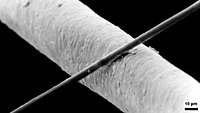
Photo from wikipedia
Woven fabric thermoplastic composites possess high specific strength and stiffness along with thermoformability. To utilize the full potential of these materials to achieve better crash-safe designs in automotive structural parts,… Click to show full abstract
Woven fabric thermoplastic composites possess high specific strength and stiffness along with thermoformability. To utilize the full potential of these materials to achieve better crash-safe designs in automotive structural parts, their crash behavior must be predicted accurately. For reliable crash simulations, strain rate-dependent material data and equally capable material modeling are required. In this study, quasi-static and high-speed tests are carried out to measure tensile and in-plane shear properties. A strain rate-dependent continuum damage mechanics model is formulated to describe the deformation and damage behavior of woven glass fabric composites. Tensile and in-plane shear tests on a lab scale are used to calibrate the material parameters of the model. The model was implemented as a user-defined material subroutine (VUMAT) for Abaqus. Experimental results from coupon tests were used to verify the results of a single-element simulation. Finally, a structural level dynamic crash test of a u-profile on a drop tower was used to validate the predictions of the user material model.
Journal Title: Journal of Reinforced Plastics and Composites
Year Published: 2022
Link to full text (if available)
Share on Social Media: Sign Up to like & get
recommendations!